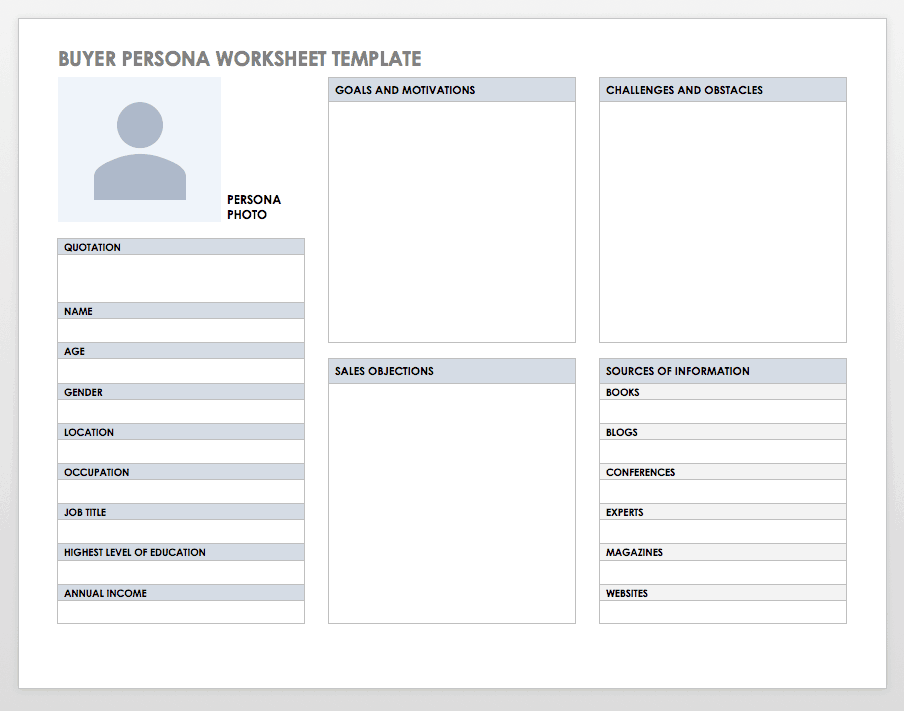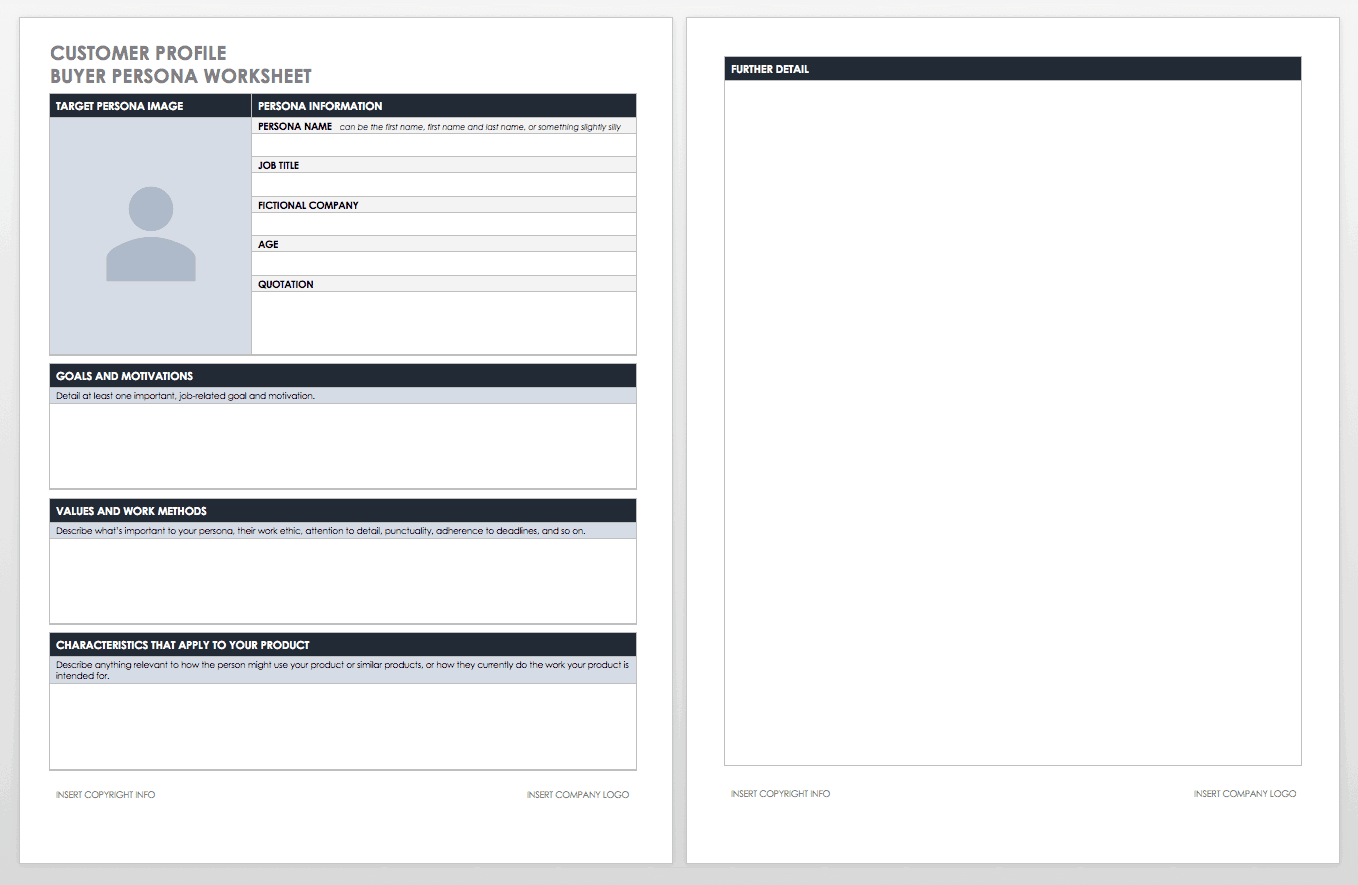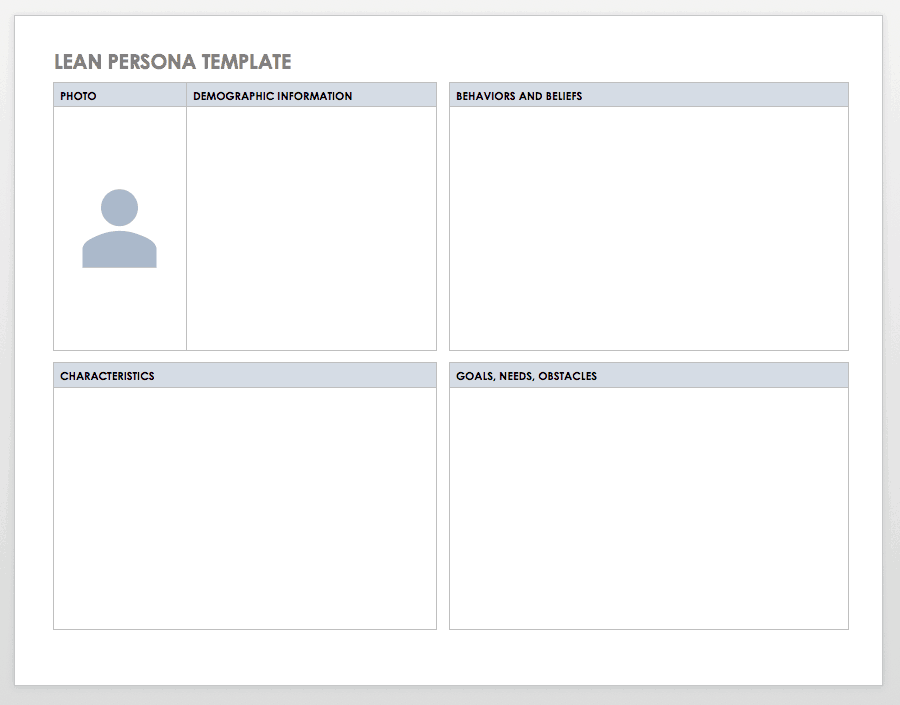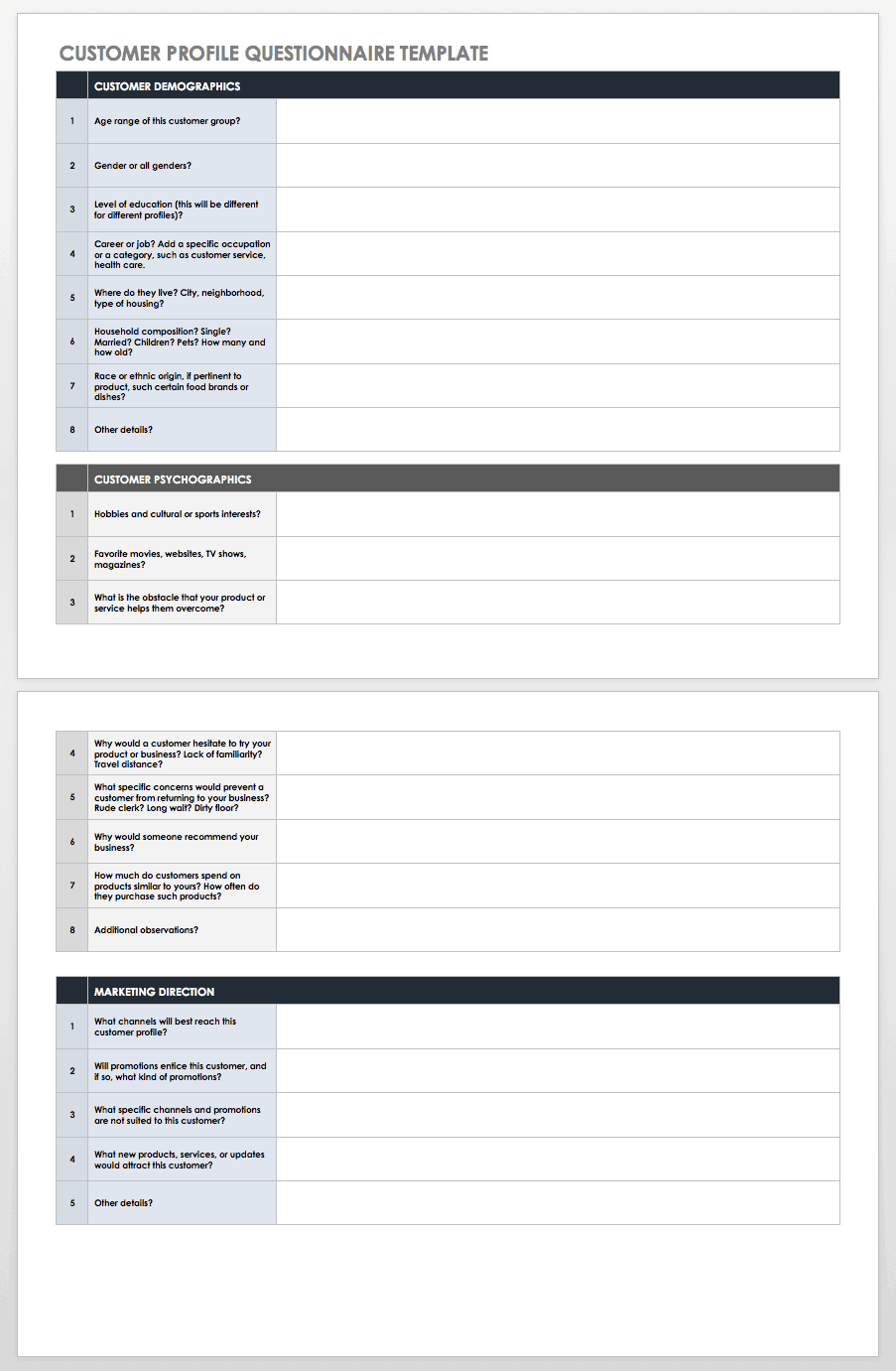Why Customer Profiles and Buyer Personas Are Important
Today, the competition for customer attention and dollars is harder than ever, so businesses need to have a better understanding of existing and potential new customers. With the variety of media channels and increasing user control over content and their experience with it, consumers have more ways to filter out the messages they receive from businesses. A universal approach to customers no longer works.
Profiles and personas help you to understand not only who wants your products, but what channels, messages, and promotions reach which customers. You can learn what aspects of layout and design will attract your customers along with the fonts, colors, and images to use. Conversely, you can also discover the types of products, promotions, and methods that don’t generate interest. Matching your product, channel, and message to customers is one of the easiest ways to gain a competitive advantage.
But marketing isn’t the only department that benefits from a thorough understanding of customers. When developing your product, buyer profiles and personas help you tailor the user experience through targeted design. Knowledge of customer context, goals, and obstacles also assists technical publications, sales, and customer service. Furthermore, understanding who you are creating the product for provides everyone on the team with a common goal, which simplifies work and the decision-making process.
You may think that tying campaigns to small target groups will result in being unable to reach certain buyers. Remember, not everyone will need or buy your product. The Pareto analysis states that most of your business will come from 20 percent of your customers. To be efficient and effective, you must find the consumers who are most likely to want your product and reach them first.
A small business or startup should learn to create personas on their own to save money (by not handing the work off to a consultant). While established businesses should iterate personas regularly, startups will likely need to perform more frequent reassessments. Understanding customers can guide a marketing and growth strategy, and provides crucial information when creating a marketing plan.
The Difference Between Buyer Profiles and Buyer Personas
Although some overlap of usage occurs between the terms persona and profile, the difference can be thought of this way: you build a profile by analyzing data which can show you quantitative patterns for group behavior; you create a persona to describe a typical representative of those groups with specific qualitative characteristics. A profile may focus more on buying behavior, whereas a person investigates the motivations for buying.
You may have more personas than profiles. Profiles should also inform your personas. The advantage of personas is that personal characteristics, such as job titles, education, likes and dislikes, and problems and needs, can be more memorable and engaging than numbers. For B2B purposes in particular, a profile finds the types of companies that form your ideal target market. The buyer persona then focuses on the type of individuals or workplace roles most likely to contact your company about products, and on their motivations.
Some marketers believe a profile provides the complete understanding of a customer. They consider personas to be semi-fictional generalizations, based not on direct contact with real customers but on market research of online sources and surveys. From this perspective, the persona focuses on what the business wants to offer, not on actual customer pain points, goals, and needs.
What Is a Persona?
A customer persona, also called a customer avatar, a buyer persona, or in product development, a user persona, is an agglomeration of characteristics of your ideal customer to form a portrait of your customer. Although the persona may contain descriptions and numbers, it tends to focus more on motivations and goals.
You may have more than one ideal customer, especially if certain characteristics appear frequently and yet, the customers have distinct goals, obstacles, and backstories. Most organizations benefit by starting with three to five personas.
Some people wrongly conflate buyer personas with customer segmentation, which studies buyer behavior when making a purchase. By contrast, a persona explores a customer’s goals and the problems they must solve. Similarly, a persona cannot be based on a real individual because it can be misleading to generalize from the experience of one person.
Personas should be regularly updated as your product and the product and marketing landscape change. You’ll also need to create new personas for each new product you introduce.
Personas are considered essential for high conversion. Yet, why don’t all businesses and marketers use personas?
“They're using very biased information to build personas,” Revella explains. “They're talking to a few customers, asking their sales people for input, or building surveys, which merely recycles their internal limited information into a new template.”
So, what is the point of a persona and how do you create a good one?
According to Revella, “First, personas require in-depth interviews with recent buyers, including those who aren't customers. Marketers must get outside of their internal thinking and biases or there is not much to gain from personas. Second, personas must do more than profile the buyer — they must reveal the persona's experience of their buying journey. The purpose of buyer personas is to help marketers understand the buyer's attitudes, questions, and concerns at each of the defining moments in their journey. Without this focus, marketers build too many personas that deliver almost no value.”
5 Rings of Buying Insight for Creating Buyer Personas
In her marketing consultancy, Revella advocates using the 5 Rings of Buying Insight, which she developed, to understand how real customers approach purchases to solve problems. The 5 Rings are not prescribed questions, but rather a framework for gaining relevant information that when combined with the basic buyer profile provide a three-dimensional understanding of the buyer. Here are the 5 Rings:
Priority Initiatives: What motivates the customer to shop now and why are other customers not shopping?
Success Factors: What does the customer expect from this solution?
Perceived Barriers: Why wouldn’t customers choose your product?
Buyers Journey: What influences the customer as they research and then choose a solution?
Decision Criteria: What about the competitors and their products is important to the customer and why?
10 Steps to Creating a Persona
You may know some answers without further research and you can start with assumptions, but you should support your answers with data or information from actual customers. Different marketing practitioners have different ways to approach creating personas. Adele Revella’s 5 Rings of Buying Insight is one. Another approach suggests sketching a description of an ideal buyer, and determining their goals and wants, the shops and websites they visit, and the keywords and phrases they use to search. Here are the steps to create your own personas:
Start Your Draft: Although you might not have all the pieces of your persona puzzle right away, you can still begin the draft and then add details as you conduct your research and interviews. Add assumptions in the blanks and then target those areas for further investigation.
Talk to Your Sales Team: Ask your sales department to describe the characteristics of existing customers. These people have already bought from you, so they can provide one means to understanding how customers approach your products.
Use Surveys: Create and deploy surveys to existing customers.
Talk to Potential and Existing Customers: Eventually, you will want to talk to potential and existing customers to strengthen your personas.
Conduct Interviews: Use the phone, Skype, or Slack to learn more about them through personal communication. Do this once or twice a year. Also consider subscribers, social media followers, and others who are regularly in touch with your company. The call need not be longer than 10 or 15 minutes.
Research the Customers of Competitors: Review LinkedIn and Facebook profiles for examples to help you understand these people and why they are buying another product.
Create the Persona or Avatar: Essentially, write down every detail you’ve learned about your ideal buyer or buyers. A template can help you start thinking about what information you need. Keep in mind that additional specific information may be pertinent to your industry.
Use Metrics: Find a way to assign a metric to subjective characteristics so you can more easily compare them among personas.
Create a Customer Journey: Sketching out a customer journey for each prospective persona may also add dimension. In a customer journey, you draw each of the steps a potential customer may go through as they encounter your site or product, investigate it, and either leave or eventually complete a purchase.
Determine Pain Points and Goals: Consider how your product addresses pain points. Even goals that are not directly related to your product may be helpful in understanding the persona and how they might use your product. It can be as important to know what doesn’t work for them as what does.
The Parts of a Persona Template
For personas, looks matter. Keep your layout consistent among personas so that it’s easier to identify similar details among different personas to make comparisons. Consider putting all personas on one sheet for easy reference. When you have a template, you don’t have to reinvent the design wheel with each new persona: Simply plug in your information and play. Icons can also be helpful as guideposts to quickly identify similar information and to add visual interest. Use infographics to leverage art to convey the context and importance of data. Find ways to visually differentiate critical aspects of each persona. Make your fonts and colors match the persona, or even render the entire persona in pictures without words. Whatever devices you choose, consider creating something short (no more than two pages) and printable that people can post in their cube and refer to easily. A persona is useless if no one uses it.
Here are the elements in a persona:
Photo: A photo helps users of the persona to make an immediate and memorable connection with the profile. Sources for photos include actual customers who represent your persona, such as from LinkedIn profiles or stock photos. Some experts suggest that photos of actors, movie characters, or celebrities are okay, but others caution that associations with their personalities, roles, or behavior may be inappropriate or may unduly influence perceptions of the persona.
Name: Giving your persona a name is a way to connect with the representation. Some experts think it can be funny, while others caution against any name that could encourage incorrect inferences about the persona.
Keywords: Use keywords to summarize each persona. Add them to a traditional persona page, or consider creating a page that makes fun use of a photo and keywords.
Introduction: Personas can focus on numbers, statistics, and isolated facts, but include an introductory paragraph to contextualize the information and create a three-dimensional image of the persona.
Demographics: Demographics help you target ad platforms or fine-tune copy, as the information can help you write to your persona. For example, geographic location and salary can be important differentiators.
Learning Style: Understand where your persona gets information to do his or her job. What particular books, magazines, websites, or courses does this persona seek out?
Behavior and Personality: These things might be shown on a sliding scale to make it easier to quickly visualize the characteristic and compare it with other personas. If pertinent, describe what their day might be like in terms of a clock or timeline.
Customer Quotation: This quotation may be an actual quote from a customer that represents the perspective of many customers in their segment. Or, this could be a summation of thoughts expressed through multiple customer conversations, emails, and help desk tickets, and other research sources. Ideally, the quote will help you understand this persona’s motivations.
Background and Context: The details of your persona’s life provide dimensionality and differentiate it from the facts in a data-based profile. Add career history, where they work, level of experience, additional training and skills, hobbies, volunteer experience, and more.
Goals and Motivations: Why would this person want or need your product? Consider performance objectives to be met, professional goals, brand reputation, management expectations, process efficiency, supplementation to resources, or lack of team experience and knowledge. Sources include sales team, support emails, and primary research.
Obstacles to Success: What is preventing the persona from achieving their goals? Is their industry or role extremely specialized? Does management not understand or care about the problems? Does recurring company turmoil prevent a concerted focus on solutions? Does the persona not understand the problem, job, or role? In addition to other sources, consider direct quotations from both existing and potential customers about these issues.
Sales Objections: Consider why buyers might reject your project. Potential objections include a poor fit for purpose, perceived poor quality, cost, or limited performance history. Consult your sales team or customer quotations in CRM or customer service emails.
Persona Worksheet Template
The persona worksheet will help you collect the information about your ideal customer persona in a consistent layout that can be printed and posted in cubicles for easy reference.
Download Persona Worksheet Template
Word
|
PDF
| Google Docs | Smartsheet
Customer Persona Template
Persona Questions
When researching or interviewing customers, questions can guide you to create your personas. The following infographic is by no means an exhaustive list of questions. Consider which other questions apply to your marketing situation.
Lean Personas
In design, web development, and Agile environments, lean personas leverage inferences about users and their wants and needs to launch persona creation — and thereby product creation. Lean personas may be drawn from characteristics of customers from the perspective of customer service, engineering, billing, or other departments. The details from such sessions generate user stories to describe the background and likely behavior of the user. Additional sources of lean persona information include web research to understand demographics and behavior, and also to gain insight into how competitors perceive their customers and market to them.
After sketching out a lean persona, interviews with actual users extract such information as demographics, cultural background, technical skills, product environment, and so on. The lean persona interviewing process, which may be short, recruits from five to about 30 subjects. Talking to real users is important because personas generated from perceptions (rather than from more scientific approaches) may steer product development in the wrong direction. Depending on the circumstances, you should derive one main persona.
Lean personas can work well to get persona research started and in rapid development environments where work can proceed with minimal oversight. Lean personas may also be used when it is not possible for budgetary or other reasons to generate detailed profiles. A lean persona is intended to be quick and easy. The organization may already have customer data. Stakeholders may have contextual information about customers; ask them for their understanding of user goals and obstacles. However, when sketching out a persona, consider asking someone outside your team or organization to conduct a brainstorming session to generate fresh ideas.
Typical Questions for Completing a Lean Persona Template
What would an ideal day or week be like? What would you be doing?
Describe one or more of your worst pain points.
How you spend a typical day or week?
How do you spend most of your time?
What are the differences between that ideal day/week and the real world?
Describe how you use this product.
How could the experience with this product be improved? What does it do well? What doesn’t it do so well?
What does this product allow you to accomplish that you otherwise couldn’t?
If you have used similar products for the same purposes, please name and describe them. Which do you prefer? Why?
What about your job do you like most? What do you like least?
How do you know when you are doing your job well?
What are your goals? What are your ambitions?
What, if anything, is preventing you from attaining your goals?
Lean Persona Template
Lean persona templates provide a quick way to sketch a persona which you can validate with coworkers or data later. Determine the job title through research, and find the customer’s goals and problems, beliefs, and behaviors as they relate to the product or project.
Download Lean Persona Template
Excel
|
Word
|
PDF
| Smartsheet
What Is a Customer Profile Template?
A profile is a generalization of a customer who is served well by your product or service. The profile is based on geographic, demographic, psychographic, financial and other statistics, and behavior patterns. When creating a persona profile, group individual customers by similar characteristics and give each segment a name and representative photo. Some of the data sought for a profile include age, ethnicity, income, education level, location, political views, favorite movies and TV programs, and more, depending on the type of product you’re marketing. For B2B marketing, a profile may appear like a customer segmentation, and applies to the similar characteristics of companies, not to an individual, which would be covered by a contact or buyer persona. An organization may create more than one customer profile.
For example, a small freelance writing shop may create a customer segment-type profile like this to describe the ideal customer group:
Mid-sized software companies
$1 - $10 million in revenue
1 - 250 employees
Zero to two-member marketing staff
Located in the Pacific Northwest
Customer Profile Questionnaire Template
This customer profile template guides you through a set of questions that will help you understand different customer groups. Think about the bigger context of each of these questions to discover more information about your ideal customer segments.
Download Customer Profile Questionnaire Template
Excel
|
Word
|
PDF
| Google Docs
How to Create a Customer Profile
Depending on your approach to profiles, creating one may involve more data research than for personas, and ultimately may involve more interviews for qualitative answers. To quickly create a profile, look in your CRM data for a handful of appropriate customers. Find the characteristics that are common, but also the ones that have the most impact on your business or product. Here’s how to get started:
Group your customers or companies by segments that are significant for you, such as most units of a certain product sold in geographic areas.
Compare these groupings to see which produces the most revenue.
Find the companies you’ve done business with that fit into this group.
Determine key contact roles or specific customers and apply the buyer personas to them.
Demographics and Psychographics in Customer Profiles
Strictly regarded, customer profiles (and personas, too) contain data about existing and potential customers, which is divided into three categories: demographics or physical characteristics; psychographics, or mental characteristics (such as goals, fears, motivations, inspirations); and behaviors. (Behaviors can also be grouped under psychographics, as in the chart below.) Gathering psychographics usually involves conversations with individuals which can be particularly helpful in illuminating the problems customers are trying to solve. This type of profile may be particular important for B2C businesses.
Demographics | Psychographics |
|---|---|
|
|
Develop goals by using this information and focusing on what you want to achieve over the next couple of months.
Where to Find Profile and Persona Details
When it comes to completing profile and persona templates with details, two schools of thought exist: One considers that well-structured conversations with customers is the only way to get accurate information about what customers want; the other sees customer conversations as one source besides many others. Whether you have the time and resources for in-depth discussions with customers may influence your choice. You can do the following to get customer information:
Examine existing primary research
Explore CRM data about your existing customer base
Find social profiles of similar people
Perform analytics on your website visitors
Survey website visitors
Talk to customers online and offline
Profile poll your website
Interview potential customers
Talk to experienced sales team members
Identify keywords and perform terms analysis
Specific resources for research include the following:
Google Ads (for projections and forecasts)
Follow.net (to gain insights into competitor websites and their visitors)
Buzzsumo or Ahrefs Content Explorer (to find the most popular questions and content around keywords)
MyBestSegments (for profiles by zip code)
Paid and free tools on Facebook to research influencers and demographics
Talk to Internal Teams to Create Personas and Profiles
When talking with internal teams, consider some of the following questions:
How are you currently marketing to our target customers?
What marketing campaigns have been the most and least successful?
What types of customers do you typically meet?
Why do different types of customers typically make a purchase?
What reasons do customers cite for selecting our company over our competitors? What are the most common objections you hear?
What demographic and other information do you have about our website visitors?
Which blog posts have received the most views, social shares, or comments?
What are the most frequently asked questions?
Which website pages receive the most impressions?
Talk to Existing and Potential Customers
You can talk to potential customers anywhere people gather around ideas related to your product. Conversations can happen on social media (for example, on your company’s Facebook page). Create website visitor surveys through SurveyMonkey, Servata, Google Surveys. Try the minimally-priced PickFu for short A/B answer questions.
Sites and Platforms That Offer Persona or Profile Creation Wizards and Other Tools
Templates and persona creation wizards can help you create and store information in a clear format, in addition to guiding you to add appropriate information. In many cases, you can add personas to your CRM so that leads are connected to similar personas to allow you to filter contacts. Your CRM may also provide a way to create personas from your contacts.
Templates and Template Examples
InFlow
Fluid
Demand Metric
FileStage
Wizards
Hubspot
UserForge
Personapp
UpClose and Persona
Xtensio
Platforms
Akoonu sales platform
McorpCXpersona for research
Create and Share Customer Personas and Profiles with Smartsheet for Marketing
The best marketing teams know the importance of effective campaign management, consistent creative operations, and powerful event logistics -- and Smartsheet helps you deliver on all three so you can be more effective and achieve more.
The Smartsheet platform makes it easy to plan, capture, manage, and report on work from anywhere, helping your team be more effective and get more done. Report on key metrics and get real-time visibility into work as it happens with roll-up reports, dashboards, and automated workflows built to keep your team connected and informed.
When teams have clarity into the work getting done, there’s no telling how much more they can accomplish in the same amount of time. Try Smartsheet for free, today.




